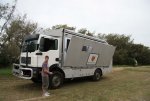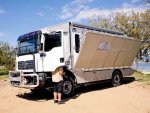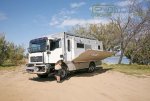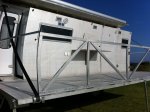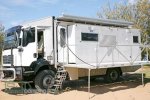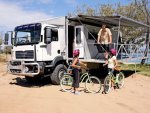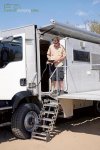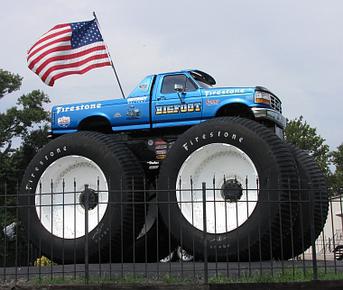You are using an out of date browser. It may not display this or other websites correctly.
You should upgrade or use an alternative browser.
You should upgrade or use an alternative browser.
TerraLiner:12 m Globally Mobile Beach House/Class-A Crossover w 6x6 Hybrid Drivetrain
- Thread starter biotect
- Start date
biotect
Designer
.
CONTINUED FROM PREVIOUS POST
*****************************************
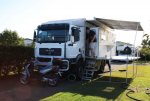
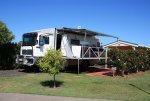
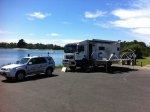

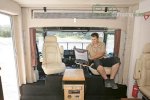


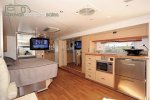

Once again, I've held up the Paradise Motorhomes Expedition Vehicle as an extremely important exemplar because of its side-mounted drop-down deck. It's the drop-down deck that interests me in this motorhome, as well as its huge slide-outs, and the fact that it has an “almost fully integrated” interior. Sure, it still has a cab that is COE, and the cab still needs to tilt forwards to provide engine-access. But otherwise, this expedition motorhome at least strives for a “fully integrated” interior appearance.
Joe made it very clear that he was posting the vehicle because of its integrated interior, and not in order to hold it up as an ideal exemplar of more optimal TerraLiner size. Those who interpreted Joe's posting this motorhome as an argument for a “medium sized” vehicle, simply failed to understand the intent behind his post.
Referencing small or mid-size vehicles because they contain a design feature that could be applied to a larger scale is perfectly legitimate in this thread. But that's not the same thing as discussing a small or mid-size motorhome as an alternative “ideal” to a much larger motorhome.
So here I should state most emphatically that this thread positively welcomes great design ideas coming from just about any and every quarter. Just as long as they are not presented as alternatives to the basic size and operational parameters that have been very clearly posited for the TerraLiner, and that are captured in the thread's title.
For instance, when Joe posted these images of the Paradise motorhome, I found myself feeling simultaneously overjoyed, blind-sided, angry, flumoxed, and a bit exhausted. But truly and profoundly grateful to Joe, and I have already written to him in private saying as much. After I saw these images, I found myself tearing up most of what I had done up to that point (hence the anger, the exhaustion), and completely changing my design direction. The central idea of the Paradise Motorhome – a side deck that folds down, and that covers all the windows when folded up – is just so darn simple, and so darn good. I could immediately see the potential in the design for massively increasing the TerraLiner's spread of solar cells via side-awnings, and for “upping” the TerraLiner's “glamp quotient”, and then some. This Paradise Motorhomes expedition vehicle hit me like a ton of bricks, and the TerraLiner design trajectory has changed dramatically as a consequence.
But to repeat, not because the Paradise Motorhome is medium-size. Joe did not “sell” it as a vehicle that exemplifies the virtues of a medium-size motorhome, and I did not read it that way. Instead, I read it as Joe intended it: as a super-cool almost-fully-integrated motorhome with lots of windows, a well-lit interior, a huge deck, and total protection against dust and rocks for said windows when underway. The size of the motorhome was irrelevant.
*****************************************
CONTINUED IN NEXT POST
.
CONTINUED FROM PREVIOUS POST
*****************************************









Once again, I've held up the Paradise Motorhomes Expedition Vehicle as an extremely important exemplar because of its side-mounted drop-down deck. It's the drop-down deck that interests me in this motorhome, as well as its huge slide-outs, and the fact that it has an “almost fully integrated” interior. Sure, it still has a cab that is COE, and the cab still needs to tilt forwards to provide engine-access. But otherwise, this expedition motorhome at least strives for a “fully integrated” interior appearance.
Joe made it very clear that he was posting the vehicle because of its integrated interior, and not in order to hold it up as an ideal exemplar of more optimal TerraLiner size. Those who interpreted Joe's posting this motorhome as an argument for a “medium sized” vehicle, simply failed to understand the intent behind his post.
Referencing small or mid-size vehicles because they contain a design feature that could be applied to a larger scale is perfectly legitimate in this thread. But that's not the same thing as discussing a small or mid-size motorhome as an alternative “ideal” to a much larger motorhome.
So here I should state most emphatically that this thread positively welcomes great design ideas coming from just about any and every quarter. Just as long as they are not presented as alternatives to the basic size and operational parameters that have been very clearly posited for the TerraLiner, and that are captured in the thread's title.
For instance, when Joe posted these images of the Paradise motorhome, I found myself feeling simultaneously overjoyed, blind-sided, angry, flumoxed, and a bit exhausted. But truly and profoundly grateful to Joe, and I have already written to him in private saying as much. After I saw these images, I found myself tearing up most of what I had done up to that point (hence the anger, the exhaustion), and completely changing my design direction. The central idea of the Paradise Motorhome – a side deck that folds down, and that covers all the windows when folded up – is just so darn simple, and so darn good. I could immediately see the potential in the design for massively increasing the TerraLiner's spread of solar cells via side-awnings, and for “upping” the TerraLiner's “glamp quotient”, and then some. This Paradise Motorhomes expedition vehicle hit me like a ton of bricks, and the TerraLiner design trajectory has changed dramatically as a consequence.
But to repeat, not because the Paradise Motorhome is medium-size. Joe did not “sell” it as a vehicle that exemplifies the virtues of a medium-size motorhome, and I did not read it that way. Instead, I read it as Joe intended it: as a super-cool almost-fully-integrated motorhome with lots of windows, a well-lit interior, a huge deck, and total protection against dust and rocks for said windows when underway. The size of the motorhome was irrelevant.
*****************************************
CONTINUED IN NEXT POST
.
Last edited:
biotect
Designer
.
CONTINUED FROM PREVIOUS POST
*****************************************
5. Every aspect of specifically large, Class-A motorhome design is a legitimate topic of discussion in this thread
*****************************************
In the monster series of posts that runs 28 pages, I addressed logistics and the operational requirements of the TerraLiner at tremendous length, because imagining hypothetical but geographically grounded scenarios has become an important aspect of my design thinking. So too, it has become important to me to think through the geography, economics, sociology, crime rates, and transportation networks of Second and Third-World countries.
As stated a number of times, on my own view many who design and/or buy large motorhomes, simply fail to think through logistics at a reasonable level of detail. They will then make fundamental mistakes, like imagining that the Third World is one, vast, uniform bloc where all roads are mud-tracks, and an expedition vehicle will need to rock-crawl 90 % of the time. Or they will fantasize that they should be able to “wild camp” with their Class-A-sized expedition motorhome in sociological contexts where this is both impractical and ill-advised.
When they discover as much, and perhaps write about their experiences on the Web, advocates of small and medium-sized motorhomes will then shout, “I told you so!!”
But the mistake was not designing or buying the large motorhome. Rather, the mistake lies in one's conception of how one would use such a large motorhome. The mistake lies in one's failure to imaginatively project the logistical possibilities in advance, as well as limits, of a globally-capable, large motorhome.
So here I want to add that every aspect of Class-A motorhome design is a legitimate topic of discussion on this thread. Even more broadly, almost any aspect of motorhome design is a legitimate topic of discussion, just as long it proves relevant to the TerraLiner's basic design parameters. And just as long as it respects and does not challenge the most basic parameters as expressed by the thread's title. So examples of valuable design features from the world of mid-size motorhomes are perfectly legitimate topics of discussion, just as long as we don't get into a debate comparing the advantages of mid-size motorhomes versus very large motorhomes. Those participating in this thread are not stupid, we all know what the trade-offs are, and nobody here needs to be reminded of them, least of all me.
I know what the trade-offs are, and I've made my choice. The TerraLiner will be very big, 12 m, because it will serve mainly as a base camp, and it will not be designed for maximum "exploring" or "geographic reach". If others don't like that decision, that's perfectly understandable. The TerraLiner is simply not for them.
*****************************************
6. Back to the Thread Title
*****************************************
Joe and Iain: what do you think of the proposal for a revised thread title?
12m Globally Mobile Beach House/Class-A Crossover, on Hybrid 6x6 Torsion-Free Chassis
I know, it doesn't incorporate the word "TerraLiner", but I can't really fit it in. The title block has as length limit, and right now it's more important to me to have a title that very clearly signals certain discussion parameters to thread participants. Perhaps I could substitute "TerraLiner" for "Crossover", but without "Crossover" in the title, the back-slash ("/") doesn't make much sense.
I figure the title above should capture where the design discussion will be going for at least the next 50 - 100 pages. And then, once that discussion has reached a certain point of fruition, I could finally change the title once more, to something as simple as:
12 m Phoenix TerraLiner: Globally Capable Class-A Surf Glamper
All best wishes,
Biotect
CONTINUED FROM PREVIOUS POST
*****************************************
5. Every aspect of specifically large, Class-A motorhome design is a legitimate topic of discussion in this thread
*****************************************
In the monster series of posts that runs 28 pages, I addressed logistics and the operational requirements of the TerraLiner at tremendous length, because imagining hypothetical but geographically grounded scenarios has become an important aspect of my design thinking. So too, it has become important to me to think through the geography, economics, sociology, crime rates, and transportation networks of Second and Third-World countries.
As stated a number of times, on my own view many who design and/or buy large motorhomes, simply fail to think through logistics at a reasonable level of detail. They will then make fundamental mistakes, like imagining that the Third World is one, vast, uniform bloc where all roads are mud-tracks, and an expedition vehicle will need to rock-crawl 90 % of the time. Or they will fantasize that they should be able to “wild camp” with their Class-A-sized expedition motorhome in sociological contexts where this is both impractical and ill-advised.
When they discover as much, and perhaps write about their experiences on the Web, advocates of small and medium-sized motorhomes will then shout, “I told you so!!”
But the mistake was not designing or buying the large motorhome. Rather, the mistake lies in one's conception of how one would use such a large motorhome. The mistake lies in one's failure to imaginatively project the logistical possibilities in advance, as well as limits, of a globally-capable, large motorhome.
So here I want to add that every aspect of Class-A motorhome design is a legitimate topic of discussion on this thread. Even more broadly, almost any aspect of motorhome design is a legitimate topic of discussion, just as long it proves relevant to the TerraLiner's basic design parameters. And just as long as it respects and does not challenge the most basic parameters as expressed by the thread's title. So examples of valuable design features from the world of mid-size motorhomes are perfectly legitimate topics of discussion, just as long as we don't get into a debate comparing the advantages of mid-size motorhomes versus very large motorhomes. Those participating in this thread are not stupid, we all know what the trade-offs are, and nobody here needs to be reminded of them, least of all me.
I know what the trade-offs are, and I've made my choice. The TerraLiner will be very big, 12 m, because it will serve mainly as a base camp, and it will not be designed for maximum "exploring" or "geographic reach". If others don't like that decision, that's perfectly understandable. The TerraLiner is simply not for them.
*****************************************
6. Back to the Thread Title
*****************************************
Joe and Iain: what do you think of the proposal for a revised thread title?
12m Globally Mobile Beach House/Class-A Crossover, on Hybrid 6x6 Torsion-Free Chassis
I know, it doesn't incorporate the word "TerraLiner", but I can't really fit it in. The title block has as length limit, and right now it's more important to me to have a title that very clearly signals certain discussion parameters to thread participants. Perhaps I could substitute "TerraLiner" for "Crossover", but without "Crossover" in the title, the back-slash ("/") doesn't make much sense.
I figure the title above should capture where the design discussion will be going for at least the next 50 - 100 pages. And then, once that discussion has reached a certain point of fruition, I could finally change the title once more, to something as simple as:
12 m Phoenix TerraLiner: Globally Capable Class-A Surf Glamper
All best wishes,
Biotect
Last edited:
Silverado08
Observer
Interesting project you have here....
**************************************************
1. A CHANGE OF THREAD TITLE
**************************************************
To all thread participants,
If possible, it would be good if we could continue discussing TerraLiner power requirements, after I've posted the following.
However, it seems time for a change of thread title. Now that I've gained a better understanding of the "programmatic" requirements of the TerraLiner, a change in the thread title would further clarify things for everyone. In particular, it would make it easier for people to decide if this is a thread in which they want to participate, and might reduce some of the recent confusion.
Yes, this may mess up some websites linked to the thread, but as near as I can tell, Google would still retain a "memory" of the old thread name, and the thread would still be accessible by that old name.
Furthermore, enough has transpired that some elements in the title have become thoroughly obsolete. "8x8" was obsolete a long time ago, and "Tatra" is no longer in the running, because Tatra does not seem to have developed in-house expertise with respect to hybrid technologies. The toss-up is now between MAN and IVECO-Astra, because these are companies large enough to have truck as well as bus divisions; because they both have in-house expertise in the design and manufacture of torsion-free frames; and because both have extensive experience with hybrid and/or electric buses. "Expedition RV" is also now obsolete and misleading, because I am not imagining the TerraLiner specifically as doing much exploring. Rather, the TerraLiner will serve as a "base camp" for sojourning, and the TOAD will do the exploring.
I also want the thread to distance itself a bit from the traditional concept of an "Expedition RV", as that concept now exists in the minds of many participants on ExPo. What I a moving towards is something rather different than their ideal of a mid-size compromise vehicle that fast-travels, and that is designed mainly to explore, and to sojourn at best only days or weeks, but not for many months. Because the concept of an "Expedition RV" is so freighted with prior associations and expectations, at least here on ExPo, it seems best to ditch the concept completely.
So instead, I am thinking of changing the thread title to the following:
12m Globally Mobile Beach House/Class-A Crossover, on Hybrid 6x6 Torsion-Free Chassis
"12m" at the very beginning would signal that if someone does not want to discuss or think about very large kinds of motorhome, then this thread is not for them. "Globally Mobile Beach House" signals lots of things, including the "Base Camp" concept, surf glamping, slow travel, and the idea of a vehicle that will be stationary for months at a time. But "Class-A Crossover" suggests that unlike most concept-designs for mobile beach houses, the TerraLiner will not be just a house on a trailer, one that needs another vehicle to move it. The TerraLiner will still be autonomously mobile, just like a regular motorhome. I would prefer to write "Mobile Beach house/Globally Capable Class-A Crossover", but there is not enough room in the title block, and perhaps global capability is already implied enough by the phrase "Globally Mobile".
"Crossover" is there to signal that this will be a new vehicle type, and to warn those who yearn for tighter and more fixed categories in transportation design that they won't find them here. "Hybrid" is obvious enough, because that has become a major preoccupation of the thread. And "6x6 Torsion-Free Chassis" preserves what is still useful in the old title.
I figure that "Mobile Beach House" combined with "Class A" and "Torsion-Free Chassis" should be enough to make it clear that the interior will be "Fully integrated", so I've eliminated "Fully Integrated" as well.
[/SIZE]
Since youve mentioned hybrid drive,and I havent read all pages in this tread,was wondering if anyone mentioned this company yet
https://youtu.be/oOYrJm23OpM
Btw
Only torsion free chassis I am familiar with in big rigs is Czech Tatra...adapting this hybrid system onto Tatra truck would be my choice..
cheers
biotect
Designer
Hi Silverado,
Yes, Capstone turbines and the Wrightspeed drive-train have been discussed in the thread, from page 50 onwards; see post #491 at http://www.expeditionportal.com/for...igid-Torsion-Free-Frame?p=1650993#post1650993 and following; and for Wrightspeed in particular, see post #496 at http://www.expeditionportal.com/for...igid-Torsion-Free-Frame?p=1652223#post1652223 , and post #505 at http://www.expeditionportal.com/for...igid-Torsion-Free-Frame?p=1652505#post1652505 .
Personally, I am still somewhat open to the idea of a microturbine generator as opposed to a more traditional diesel generator, but only if a microturbine could run on diesel fuel. I would be even more open to a microturbine generator if it were multi-fuel capable. But there have been practical problems with implementation of microturbine-based hybrid solutions. For instance, see post #495 about the problems with the NYC prototype transit buses made by DesignLine, at http://www.expeditionportal.com/for...igid-Torsion-Free-Frame?p=1652222#post1652222 .
On the other hand Wrightspeed seems to be a more competent and serious company than DesignLine, and Wrightspeed just received an order for 25 drivetrains from Federal Express, which will test them in a rigorous pilot program -- see https://www.wrightspeed.com , https://www.wrightspeed.com/news/ , and https://www.wrightspeed.com/products/the-route/ . Ian Wright is a cofounder of Tesla, so he has serious credibility in the automotive industry -- http://www.thestreet.com/story/1312...focus-from-sports-cars-to-garbage-trucks.html ,http://www.fool.com/investing/gener...founder-putting-jet-tu.aspx#commentsBoxAnchor , and http://finance.yahoo.com/news/forge...ion-is-electric-garbage-trucks-175357428.html . Although DesignLine was doing quite well when it was still a New Zealand-based, New Zealand owned-and-operated company, DesignLine went to hell when bought out by some American yahoos from North Carolina, and DesignLine filed for bankruptcy in 2013 -- see http://www.bizjournals.com/charlotte/news/2013/08/16/charlotte-hybrid-busmaker-designline.html . One American-built DesignLine bus spontaneously caught fire, allegedly because its battery bank overheated, and the battery bank most probably overheated because it was located beside the microturbine at the back of the vehicle.
There is also the issue of practical build-ability. As Iain suggested, the ideal solution for the base chassis of the TerraLiner will be a rigid frame and 6x6 configuration together with a hybrid drivetrain all built by just one manufacturer. MAN and IVECO-Astra both have enough competence in-house to be able to do the complete job. Wrightspeed does not have this total competence, and on its website Wrightspeed emphasizes that it is only a drivetrain company, and that it does not build vehicles -- see https://www.wrightspeed.com/about/. For a bad-road and occasionally off-road capable TerraLiner, the devil will be in the engineering details, and adapting the Wrightspeed drivetrain to a 6x6 bad-road application may prove very complicated and costly. As suggested by Iain, the TerraLiner should be innovative mostly in terms of how it combines technology that is already available "off the shelf". Or technology that only entails a certain degree of customization of an existing product, for instance, customization of a torsion-free base-chassis manufactured by MAN or IVECO-Astra. But I would not want huge amounts of energy and capital spent getting bogged down in the R&D required to create a completely new road-worthy drivetrain, or a completely new sort of single-piece tubular space-frame chassis.
The camper body will still be a very rigid "semi-monocoque" tubular space frame construction, one in which the aluminum skin works in concert with the aluminum frame (and the steel roll-bars embedded within the frame) to create a structurally integrated whole, much like the Airstream camper body in the following vintage movie (skip ahead 7 minutes into the video):
No, I would not want the aluminum skin merely riveted to the frame, and much more advanced methods of aluminum-skin-to-aluminum-frame fabrication are now available, even though Airstream does not use them, and still rivets its campers. For instance, Newell seems to weld aluminum skins onto its aluminum frames, with fiberglass end-caps, so that the camper body can have a more curvilinear appearance:
The general point here is that the camper body versus the underlying "base chassis" should be developed separately, and that creating a sophisticated camper body and its interior fittings should be where most of the R&D money gets spent. As per the Airstream video, this camper body would then get bolted to a base chassis that's also very rigid, but that is made of steel instead, and not aluminum. Once combined, the two would become a single unified rigid space frame. This seems to me by far the best solution from a materials point of view, and this is also the solution that Kimberley uses, in its "hybrid" two-material chassis. It's also the best solution from a logistical point of view, because it allows one manufacturer to focus on creating the base chassis made out of steel along with the hybrid drivetrain, while a second manufacturer focuses on creating the camper body.
With that said, however, yes, I am still somewhat open to the idea of a microturbine-generator based hybrid drivetrain, even if this might involve quite a bit more R&D....:ylsmoke: ... The question here would be just how much more R&D, and how much it would cost.
As for Tatra, the problem there is that the drive-train is the torsion-free Tatra backbone tube, and the torsion-free backbone tube is the drive-train. In Tatra trucks, the torsion-free chassis and the drivetrain are one and the same thing, and cannot be separated. Whereas in a hybrid solution with three electric motors, one would probably have no use for the Tatra backbone tube as drive-train. One still needs the torsion-free chassis, but one does not need the backbone tube drivetrain. Some have suggested that one might insert electric motors along the length of the Tatra backbone tube, but I am not quite sure what they meant by that, or whether the idea has any value. You seem to be in favor of Tatra, so how would you configure a Tatra backbone tube with three electric motors?
Tatra also does not seem to have in-house competence when it comes to hybrid drivetrains, and does not have massive competence when it comes to electric and hybrid buses, as per MAN and IVECO.
In any case, many thanks for your post, because it returns the thread discussion to the discussion of power, and the TerraLiner drive-train. I am still wondering what the efficiency loss might be for just three cross-axle transmissions driven by three electric motors. Iain has been calculating that the efficiency loss for the transmission in a conventional diesel truck driving 3 axles is at least 30 %, especially in an AWD 6x6 configuration. Haf-E then suggested that the efficiency loss for three merely cross-axle transmissions would be much less than that. But I wonder how much less?
All best wishes,
Biotect
Yes, Capstone turbines and the Wrightspeed drive-train have been discussed in the thread, from page 50 onwards; see post #491 at http://www.expeditionportal.com/for...igid-Torsion-Free-Frame?p=1650993#post1650993 and following; and for Wrightspeed in particular, see post #496 at http://www.expeditionportal.com/for...igid-Torsion-Free-Frame?p=1652223#post1652223 , and post #505 at http://www.expeditionportal.com/for...igid-Torsion-Free-Frame?p=1652505#post1652505 .
Personally, I am still somewhat open to the idea of a microturbine generator as opposed to a more traditional diesel generator, but only if a microturbine could run on diesel fuel. I would be even more open to a microturbine generator if it were multi-fuel capable. But there have been practical problems with implementation of microturbine-based hybrid solutions. For instance, see post #495 about the problems with the NYC prototype transit buses made by DesignLine, at http://www.expeditionportal.com/for...igid-Torsion-Free-Frame?p=1652222#post1652222 .
On the other hand Wrightspeed seems to be a more competent and serious company than DesignLine, and Wrightspeed just received an order for 25 drivetrains from Federal Express, which will test them in a rigorous pilot program -- see https://www.wrightspeed.com , https://www.wrightspeed.com/news/ , and https://www.wrightspeed.com/products/the-route/ . Ian Wright is a cofounder of Tesla, so he has serious credibility in the automotive industry -- http://www.thestreet.com/story/1312...focus-from-sports-cars-to-garbage-trucks.html ,http://www.fool.com/investing/gener...founder-putting-jet-tu.aspx#commentsBoxAnchor , and http://finance.yahoo.com/news/forge...ion-is-electric-garbage-trucks-175357428.html . Although DesignLine was doing quite well when it was still a New Zealand-based, New Zealand owned-and-operated company, DesignLine went to hell when bought out by some American yahoos from North Carolina, and DesignLine filed for bankruptcy in 2013 -- see http://www.bizjournals.com/charlotte/news/2013/08/16/charlotte-hybrid-busmaker-designline.html . One American-built DesignLine bus spontaneously caught fire, allegedly because its battery bank overheated, and the battery bank most probably overheated because it was located beside the microturbine at the back of the vehicle.
There is also the issue of practical build-ability. As Iain suggested, the ideal solution for the base chassis of the TerraLiner will be a rigid frame and 6x6 configuration together with a hybrid drivetrain all built by just one manufacturer. MAN and IVECO-Astra both have enough competence in-house to be able to do the complete job. Wrightspeed does not have this total competence, and on its website Wrightspeed emphasizes that it is only a drivetrain company, and that it does not build vehicles -- see https://www.wrightspeed.com/about/. For a bad-road and occasionally off-road capable TerraLiner, the devil will be in the engineering details, and adapting the Wrightspeed drivetrain to a 6x6 bad-road application may prove very complicated and costly. As suggested by Iain, the TerraLiner should be innovative mostly in terms of how it combines technology that is already available "off the shelf". Or technology that only entails a certain degree of customization of an existing product, for instance, customization of a torsion-free base-chassis manufactured by MAN or IVECO-Astra. But I would not want huge amounts of energy and capital spent getting bogged down in the R&D required to create a completely new road-worthy drivetrain, or a completely new sort of single-piece tubular space-frame chassis.
The camper body will still be a very rigid "semi-monocoque" tubular space frame construction, one in which the aluminum skin works in concert with the aluminum frame (and the steel roll-bars embedded within the frame) to create a structurally integrated whole, much like the Airstream camper body in the following vintage movie (skip ahead 7 minutes into the video):
No, I would not want the aluminum skin merely riveted to the frame, and much more advanced methods of aluminum-skin-to-aluminum-frame fabrication are now available, even though Airstream does not use them, and still rivets its campers. For instance, Newell seems to weld aluminum skins onto its aluminum frames, with fiberglass end-caps, so that the camper body can have a more curvilinear appearance:
The general point here is that the camper body versus the underlying "base chassis" should be developed separately, and that creating a sophisticated camper body and its interior fittings should be where most of the R&D money gets spent. As per the Airstream video, this camper body would then get bolted to a base chassis that's also very rigid, but that is made of steel instead, and not aluminum. Once combined, the two would become a single unified rigid space frame. This seems to me by far the best solution from a materials point of view, and this is also the solution that Kimberley uses, in its "hybrid" two-material chassis. It's also the best solution from a logistical point of view, because it allows one manufacturer to focus on creating the base chassis made out of steel along with the hybrid drivetrain, while a second manufacturer focuses on creating the camper body.
With that said, however, yes, I am still somewhat open to the idea of a microturbine-generator based hybrid drivetrain, even if this might involve quite a bit more R&D....:ylsmoke: ... The question here would be just how much more R&D, and how much it would cost.
As for Tatra, the problem there is that the drive-train is the torsion-free Tatra backbone tube, and the torsion-free backbone tube is the drive-train. In Tatra trucks, the torsion-free chassis and the drivetrain are one and the same thing, and cannot be separated. Whereas in a hybrid solution with three electric motors, one would probably have no use for the Tatra backbone tube as drive-train. One still needs the torsion-free chassis, but one does not need the backbone tube drivetrain. Some have suggested that one might insert electric motors along the length of the Tatra backbone tube, but I am not quite sure what they meant by that, or whether the idea has any value. You seem to be in favor of Tatra, so how would you configure a Tatra backbone tube with three electric motors?
Tatra also does not seem to have in-house competence when it comes to hybrid drivetrains, and does not have massive competence when it comes to electric and hybrid buses, as per MAN and IVECO.
In any case, many thanks for your post, because it returns the thread discussion to the discussion of power, and the TerraLiner drive-train. I am still wondering what the efficiency loss might be for just three cross-axle transmissions driven by three electric motors. Iain has been calculating that the efficiency loss for the transmission in a conventional diesel truck driving 3 axles is at least 30 %, especially in an AWD 6x6 configuration. Haf-E then suggested that the efficiency loss for three merely cross-axle transmissions would be much less than that. But I wonder how much less?
All best wishes,
Biotect
Last edited:
A note on turbine engines.
Ones like capstone used to strike me as extremely heavy.
I decided to take a look at what is used to power small helicopters and found many engines with way greater power to weight.
The lightest with enough power that I found quickly is a 50-year old Allison 250-C20B, which provides 370 continuous HP for 73 kg. Convert to diesel, add a generator and have a gen-set that weights 150 kg while providing 200 kW. Both numbers are conservative.
Ones like capstone used to strike me as extremely heavy.
I decided to take a look at what is used to power small helicopters and found many engines with way greater power to weight.
The lightest with enough power that I found quickly is a 50-year old Allison 250-C20B, which provides 370 continuous HP for 73 kg. Convert to diesel, add a generator and have a gen-set that weights 150 kg while providing 200 kW. Both numbers are conservative.
biotect
Designer
Wow.
Very interesting, safas. I wonder if a more recent and equivalent helicopter turbine exists. One of my concerns about Capstone turbines, for instance, is that although they claim to be "bearing-less", because they have "air bearings" which need no oil, there remains the question of how well they would work when fitted to a vehicle that travels on very bad, corrugated gravel roads. So far Capstone turbines have been implemented only in "good road" transportation applications, like transit buses and garbage trucks. By way of contrast, a helicopter turbine needs to handle bumpy landings, as well as turbulence in the air. Turbulence in the air is not quite the same thing as the bumps and shocks of corrugated gravel roads. But at least a helicopter turbine will have a long history of use in a fairly demanding transportation context. Whereas over the last 2 or 3 decades Capstone turbines have been used primarily for small-scale power generation, with only occasional, experimental forays into transportation contexts.
If you ever come across a new small helicopter turbine that weighs the same or less, with a similar HP figure, please post at length!! 200 KW sounds like the right ballpark, because I estimated that the TerraLiner's electric motors should total about 420 KW, reasoning on the basis of 18.5 m long electric bus trolleys that have motors totaling 320 KW (maximum power) -- see posts #1986 at #1988, at http://www.expeditionportal.com/for...igid-Torsion-Free-Frame?p=1964735#post1964735 . If two generators were producing 420 KW, then in the course of normal running operation they would not only be driving the electric motors, they would also be charging the battery bank, because the electric motors would not be draining their maximu power, i.e. 420 KW. Indeed, because 420 KW would be completely unnecessary in many situations (like driving on a flat surface), it's possible that for at least 50 % of the time only one diesel generator might be running. But if 420 KW were available from the generators, then even during "peak" power periods, like climbing an incline, the generators could keep the electric motors supplied, with only minimal drain-down of the batteries.
This may or may not be desirable, and again, the ultimate issue here is striking the right balance between the size of the battery bank and size of the diesel generators. If the diesel generators were in fact as light as 150 kg each, and yet were producing 200 KW each, then having a second diesel generator makes far more sense than having more batteries. The superior power-to-weight ratio of the diesel generators would obvious. So we'd no longer specify the size of the battery bank based upon the KW necessary to sustain peak power on an incline. Rather, the only real consideration would be how large a battery bank needs to be in order to sustain the TerraLiner's camper systems when stationary and glamping, for a specified optimal number of days, without relying on solar or the diesel generators.
Note that Oshkosh claims that its "pure diesel electric" solution still realizes fuel savings of 20 - 30 % (whatever that means.... ), in a configuration where a big diesel generator provides all the power that the electric motors need, including maximum peak power, and where no battery bank serves as a buffer. So if the TerraLiner's diesel generators were producing 420 KW to match the peak power demand of the electric motors, we'd have a configuration somewhat akin to Oshkosh's "ProPulse" solution. I think Oshkosh "ProPulse" vehicles handle regenerative braking via super-capacitors, and the TerraLiner would probably want do the same. Why? Because super-capacitors seem to be much better at absorbing the surges of electric power that come from regenerative braking, or so I've been told. But the TerraLiner will still need a reasonably large lith-ion battery bank, for glamping with solar.....
), in a configuration where a big diesel generator provides all the power that the electric motors need, including maximum peak power, and where no battery bank serves as a buffer. So if the TerraLiner's diesel generators were producing 420 KW to match the peak power demand of the electric motors, we'd have a configuration somewhat akin to Oshkosh's "ProPulse" solution. I think Oshkosh "ProPulse" vehicles handle regenerative braking via super-capacitors, and the TerraLiner would probably want do the same. Why? Because super-capacitors seem to be much better at absorbing the surges of electric power that come from regenerative braking, or so I've been told. But the TerraLiner will still need a reasonably large lith-ion battery bank, for glamping with solar.....
****************************************
1. Le Tourneau Diesel-Electric Loaders and Log Stackers
****************************************
safas, a while back you made a brief reference to Le Tourneu, in post #1516 at http://www.expeditionportal.com/for...igid-Torsion-Free-Frame?p=1866498#post1866498 :
I researched Le Tourneau in depth, and it turns out that it's a company that makes heavy-duty diesel-electric vehicles for both forestry and mining.
Here are some videos of Le Tourneau diesel-electric loaders. Yes, even the monster-sized L2350 shown in the first four videos is diesel-electric -- see https://en.wikipedia.org/wiki/LeTourneau_Technologies , https://en.wikipedia.org/wiki/LeTourneau_L-2350 , https://en.wikipedia.org/wiki/Rowan_Companies , and https://en.wikipedia.org/wiki/R._G._LeTourneau :
[video=youtube;KtXK2GL8T7o]https://www.youtube.com/watch?v=KtXK2GL8T7o [/video]
*****************************************
CONTINUED IN NEXT POST
.
Very interesting, safas. I wonder if a more recent and equivalent helicopter turbine exists. One of my concerns about Capstone turbines, for instance, is that although they claim to be "bearing-less", because they have "air bearings" which need no oil, there remains the question of how well they would work when fitted to a vehicle that travels on very bad, corrugated gravel roads. So far Capstone turbines have been implemented only in "good road" transportation applications, like transit buses and garbage trucks. By way of contrast, a helicopter turbine needs to handle bumpy landings, as well as turbulence in the air. Turbulence in the air is not quite the same thing as the bumps and shocks of corrugated gravel roads. But at least a helicopter turbine will have a long history of use in a fairly demanding transportation context. Whereas over the last 2 or 3 decades Capstone turbines have been used primarily for small-scale power generation, with only occasional, experimental forays into transportation contexts.
If you ever come across a new small helicopter turbine that weighs the same or less, with a similar HP figure, please post at length!! 200 KW sounds like the right ballpark, because I estimated that the TerraLiner's electric motors should total about 420 KW, reasoning on the basis of 18.5 m long electric bus trolleys that have motors totaling 320 KW (maximum power) -- see posts #1986 at #1988, at http://www.expeditionportal.com/for...igid-Torsion-Free-Frame?p=1964735#post1964735 . If two generators were producing 420 KW, then in the course of normal running operation they would not only be driving the electric motors, they would also be charging the battery bank, because the electric motors would not be draining their maximu power, i.e. 420 KW. Indeed, because 420 KW would be completely unnecessary in many situations (like driving on a flat surface), it's possible that for at least 50 % of the time only one diesel generator might be running. But if 420 KW were available from the generators, then even during "peak" power periods, like climbing an incline, the generators could keep the electric motors supplied, with only minimal drain-down of the batteries.
This may or may not be desirable, and again, the ultimate issue here is striking the right balance between the size of the battery bank and size of the diesel generators. If the diesel generators were in fact as light as 150 kg each, and yet were producing 200 KW each, then having a second diesel generator makes far more sense than having more batteries. The superior power-to-weight ratio of the diesel generators would obvious. So we'd no longer specify the size of the battery bank based upon the KW necessary to sustain peak power on an incline. Rather, the only real consideration would be how large a battery bank needs to be in order to sustain the TerraLiner's camper systems when stationary and glamping, for a specified optimal number of days, without relying on solar or the diesel generators.
Note that Oshkosh claims that its "pure diesel electric" solution still realizes fuel savings of 20 - 30 % (whatever that means....
****************************************
1. Le Tourneau Diesel-Electric Loaders and Log Stackers
****************************************
safas, a while back you made a brief reference to Le Tourneu, in post #1516 at http://www.expeditionportal.com/for...igid-Torsion-Free-Frame?p=1866498#post1866498 :
I found a precedent for an off-road truck with a series hybrid drivetrain and in-wheel-motors. And no friction brakes.
http://s4.e-monsite.com/2011/08/30/62869162letourneau-transporter-series-t-pdf.pdf
It's from 1969.
BTW, the company still does such hybrids, although it changed owner and name since then.
Example:
http://www.phmining.com/MinePro/Literature/Brochures/559294.pdf
I researched Le Tourneau in depth, and it turns out that it's a company that makes heavy-duty diesel-electric vehicles for both forestry and mining.
Here are some videos of Le Tourneau diesel-electric loaders. Yes, even the monster-sized L2350 shown in the first four videos is diesel-electric -- see https://en.wikipedia.org/wiki/LeTourneau_Technologies , https://en.wikipedia.org/wiki/LeTourneau_L-2350 , https://en.wikipedia.org/wiki/Rowan_Companies , and https://en.wikipedia.org/wiki/R._G._LeTourneau :
[video=youtube;KtXK2GL8T7o]https://www.youtube.com/watch?v=KtXK2GL8T7o [/video]
*****************************************
CONTINUED IN NEXT POST
.
Last edited:
biotect
Designer
.
CONTINUED FROM PREVIOUS POST
*****************************************
Next, here are some videos of Le Touneau diesel-electric loggger-stackers:
[video=youtube;srlObHHGoOY]https://www.youtube.com/watch?v=srlObHHGoOY [/video] [video=youtube;bOQzx9eXnLU]https://www.youtube.com/watch?v=bOQzx9eXnLU [/video]
[video=youtube;9s75Y_KYiq8]https://www.youtube.com/watch?v=9s75Y_KYiq8 [/video] [video=youtube;aMIxv5rw7kw]https://www.youtube.com/watch?v=aMIxv5rw7kw [/video]
[video=youtube;3Z3d_UldJuY]https://www.youtube.com/watch?v=3Z3d_UldJuY [/video]
[video=youtube;4VRJ6dI0yps]https://www.youtube.com/watch?v=4VRJ6dI0yps [/video]
It's rather incredible watching these heavy-duty behemoths operating in very challenging contexts, and one has to constantly remind oneself that each wheel is driven by an independent electric motor.
*****************************************
CONTINUED IN NEXT POST
.
CONTINUED FROM PREVIOUS POST
*****************************************
Next, here are some videos of Le Touneau diesel-electric loggger-stackers:
[video=youtube;srlObHHGoOY]https://www.youtube.com/watch?v=srlObHHGoOY [/video] [video=youtube;bOQzx9eXnLU]https://www.youtube.com/watch?v=bOQzx9eXnLU [/video]
[video=youtube;9s75Y_KYiq8]https://www.youtube.com/watch?v=9s75Y_KYiq8 [/video] [video=youtube;aMIxv5rw7kw]https://www.youtube.com/watch?v=aMIxv5rw7kw [/video]
[video=youtube;3Z3d_UldJuY]https://www.youtube.com/watch?v=3Z3d_UldJuY [/video]
[video=youtube;4VRJ6dI0yps]https://www.youtube.com/watch?v=4VRJ6dI0yps [/video]
It's rather incredible watching these heavy-duty behemoths operating in very challenging contexts, and one has to constantly remind oneself that each wheel is driven by an independent electric motor.
*****************************************
CONTINUED IN NEXT POST
.
Last edited:
biotect
Designer
.
CONTINUED FROM PREVIOUS POST
*****************************************
And here is what appears to be a vintage video of a Le Tourneau diesel-electric digger:
Perhaps most surprising of all, during the 1950's Le Tourneau created a number of diesel-electric "Road Trains", including a "Snow Train" for use in Alaska -- see https://en.wikipedia.org/wiki/Overland_train ,
[video=youtube;lh-EeZLm6dI]https://www.youtube.com/watch?v=lh-EeZLm6dI [/video]
[video=youtube;6_SfjoSg9nU]https://www.youtube.com/watch?v=6_SfjoSg9nU [/video] [video=youtube;Uio3HgeSRTI]https://www.youtube.com/watch?v=Uio3HgeSRTI [/video]
Although the first versions were powered by a diesel generator, in order to save weight and increase power, later versions switched to a gas turbine generator (sound familiar?):
*****************************************
CONTINUED IN NEXT POST
.
CONTINUED FROM PREVIOUS POST
*****************************************
And here is what appears to be a vintage video of a Le Tourneau diesel-electric digger:
Perhaps most surprising of all, during the 1950's Le Tourneau created a number of diesel-electric "Road Trains", including a "Snow Train" for use in Alaska -- see https://en.wikipedia.org/wiki/Overland_train ,
[video=youtube;lh-EeZLm6dI]https://www.youtube.com/watch?v=lh-EeZLm6dI [/video]
[video=youtube;6_SfjoSg9nU]https://www.youtube.com/watch?v=6_SfjoSg9nU [/video] [video=youtube;Uio3HgeSRTI]https://www.youtube.com/watch?v=Uio3HgeSRTI [/video]
Although the first versions were powered by a diesel generator, in order to save weight and increase power, later versions switched to a gas turbine generator (sound familiar?):
One change was the removal of the Cummins engines and their replacement with gas turbine engines of higher power and lower weight. Whereas the LCC-1 had a single 600-hp engine, the Overland Train had four 1,170-hp Solar 10MC engines, one in the "control car" and three others spread through the train. New power trailers could be added at any point along the train. To further reduce weight, most of the vehicle was built from welded aluminum
*****************************************
CONTINUED IN NEXT POST
.
Last edited:
biotect
Designer
.
CONTINUED FROM PREVIOUS POST
*****************************************
Now here is the thing: in 2011, Le Tourneau was sold to Joy Global, a Chinese company. So there no longer exists a Le Tourneau website where one can find information -- see http://www.mining.com/joy-global-announces-acquisition-of-letourneau-technologies/ and http://investors.joyglobal.com/releasedetail.cfm?releaseid=577477 .
Instead, on the Joy Global website one finds Le Tourneau's product line of Logger-Stackers, along with PDFs that were clearly created by Le Tourneau -- see http://www.joyglobal.com/products/forestry-log-stackers , http://www.joyglobal.com/products/forestry-log-stackers/35-series-log-stackers , http://www.joyglobal.com/docs/defau...uments/non-mining-products/3592.pdf?sfvrsn=16 , http://www.joyglobal.com/products/forestry-log-stackers/45-series-log-stackers , http://www.joyglobal.com/docs/defau...ents/non-mining-products/459294.pdf?sfvrsn=16 , http://www.joyglobal.com/products/forestry-log-stackers/50-series-log-stackers , http://www.joyglobal.com/docs/defau...ents/non-mining-products/509294.pdf?sfvrsn=14 , http://www.joyglobal.com/products/forestry-log-stackers/55-series-log-stackers , and http://www.joyglobal.com/docs/defau...ents/non-mining-products/559294.pdf?sfvrsn=14.
One also finds Le Tourneau's Wheel Loaders, again, complete with the old PDFs -- see http://www.joyglobal.com/surface-mining/wheel-loaders, http://www.joyglobal.com/product-details/l-950 , http://www.joyglobal.com/docs/defau...50spec01_ph_l-950_specification.pdf?sfvrsn=14 , http://www.joyglobal.com/product-details/l-1150, http://www.joyglobal.com/docs/defau...0spec01_ph_l-1150_specification.pdf?sfvrsn=14 , http://www.joyglobal.com/product-details/l-1350 , http://www.joyglobal.com/docs/defau...0spec01_ph_l-1350_specification.pdf?sfvrsn=14 , http://www.joyglobal.com/product-details/l-1850 , http://www.joyglobal.com/docs/defau...0spec01_ph_l-1850_specification.pdf?sfvrsn=16 , http://www.joyglobal.com/product-details/l-2350 , and http://www.joyglobal.com/docs/defau...0spec01_ph_l-2350_specification.pdf?sfvrsn=14 .
All of these vehicles are much, much heavier than the TerraLiner's projected weight. For instance, even the smallest Logger-Stacker has an operating weight of 61,236 kg, and even the smallest Wheel Loader has an operating weight of 102,275 kg. But even still, the PDF of the smallest Logger-Stacker is worth posting, because it suggests that this vehicle makes do with just a 400 - 475 HP engine, which in 4x4 configuration seems to power a generator producing 700 KW. Which doesn't make much sense, because 475 HP is just 354 KW...... In any case, 700 KW then powers electric motors designated as 200 HP in front, and 100 HP in back, but it's not clear whether 200 and 100 are "total" HP figures, or figures for each electric motor considered separately:
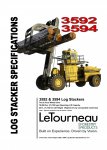
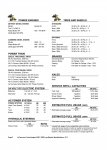
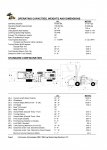
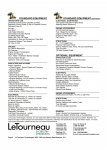
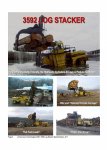
The thing I take away from this is the HP figure for the main engine that drives the diesel generator: just 400 - 474 HP. Which seems quite surprising, for an off-road capable vehicle that weighs 60 tons, and that can carry a load of logs weighing another 32 tons. Granted, Le Tourneau's Logger-Stackers won't have to climb long steep highway inclines, and their top speed is no doubt well short of 90 kph.
But still, Le Tourneau's vehicles are very interesting, because aside from Oshkosh's ProPulse vehicles, and Pisten Bully and Prinoth diesel-eletric snow groomers, these are the only other major examples we've been able to find (so far) of electric propulsion used in a very challenging, off-road environment. Above all, these Le Tourneau Wheel Loaders and Logger-Stackers are not mere prototypes or vaporware. For Pisten Bully and Prinoth snow groomers, see posts #934 to #936 at http://www.expeditionportal.com/for...igid-Torsion-Free-Frame?p=1732824#post1732824 and following. Perhaps we might also add to our short-list the diesel-electric hybrid Amfibus made by DATV, even though it was not specifically designed for off-road travel -- see posts #629 and #630 at http://www.expeditionportal.com/for...gid-Torsion-Free-Frame?p=1667492#post1667492; post #1098 at http://www.expeditionportal.com/for...igid-Torsion-Free-Frame?p=1738762#post1738762 ; and post #1852 at http://www.expeditionportal.com/for...igid-Torsion-Free-Frame?p=1933504#post1933504 .
For more material about Le Tourneau, see http://contractormag.co.nz/classic-machines/ccnz-news/ , http://www.heavyequipmentguide.ca/company/2365/letourneau-technologies-inc , and http://www.heavyequipmentguide.ca/article/11493/letourneau-hybrid-loader-with-lincs-ii-control .
All best wishes,
Biotect
CONTINUED FROM PREVIOUS POST
*****************************************
Now here is the thing: in 2011, Le Tourneau was sold to Joy Global, a Chinese company. So there no longer exists a Le Tourneau website where one can find information -- see http://www.mining.com/joy-global-announces-acquisition-of-letourneau-technologies/ and http://investors.joyglobal.com/releasedetail.cfm?releaseid=577477 .
Instead, on the Joy Global website one finds Le Tourneau's product line of Logger-Stackers, along with PDFs that were clearly created by Le Tourneau -- see http://www.joyglobal.com/products/forestry-log-stackers , http://www.joyglobal.com/products/forestry-log-stackers/35-series-log-stackers , http://www.joyglobal.com/docs/defau...uments/non-mining-products/3592.pdf?sfvrsn=16 , http://www.joyglobal.com/products/forestry-log-stackers/45-series-log-stackers , http://www.joyglobal.com/docs/defau...ents/non-mining-products/459294.pdf?sfvrsn=16 , http://www.joyglobal.com/products/forestry-log-stackers/50-series-log-stackers , http://www.joyglobal.com/docs/defau...ents/non-mining-products/509294.pdf?sfvrsn=14 , http://www.joyglobal.com/products/forestry-log-stackers/55-series-log-stackers , and http://www.joyglobal.com/docs/defau...ents/non-mining-products/559294.pdf?sfvrsn=14.
One also finds Le Tourneau's Wheel Loaders, again, complete with the old PDFs -- see http://www.joyglobal.com/surface-mining/wheel-loaders, http://www.joyglobal.com/product-details/l-950 , http://www.joyglobal.com/docs/defau...50spec01_ph_l-950_specification.pdf?sfvrsn=14 , http://www.joyglobal.com/product-details/l-1150, http://www.joyglobal.com/docs/defau...0spec01_ph_l-1150_specification.pdf?sfvrsn=14 , http://www.joyglobal.com/product-details/l-1350 , http://www.joyglobal.com/docs/defau...0spec01_ph_l-1350_specification.pdf?sfvrsn=14 , http://www.joyglobal.com/product-details/l-1850 , http://www.joyglobal.com/docs/defau...0spec01_ph_l-1850_specification.pdf?sfvrsn=16 , http://www.joyglobal.com/product-details/l-2350 , and http://www.joyglobal.com/docs/defau...0spec01_ph_l-2350_specification.pdf?sfvrsn=14 .
All of these vehicles are much, much heavier than the TerraLiner's projected weight. For instance, even the smallest Logger-Stacker has an operating weight of 61,236 kg, and even the smallest Wheel Loader has an operating weight of 102,275 kg. But even still, the PDF of the smallest Logger-Stacker is worth posting, because it suggests that this vehicle makes do with just a 400 - 475 HP engine, which in 4x4 configuration seems to power a generator producing 700 KW. Which doesn't make much sense, because 475 HP is just 354 KW...... In any case, 700 KW then powers electric motors designated as 200 HP in front, and 100 HP in back, but it's not clear whether 200 and 100 are "total" HP figures, or figures for each electric motor considered separately:





The thing I take away from this is the HP figure for the main engine that drives the diesel generator: just 400 - 474 HP. Which seems quite surprising, for an off-road capable vehicle that weighs 60 tons, and that can carry a load of logs weighing another 32 tons. Granted, Le Tourneau's Logger-Stackers won't have to climb long steep highway inclines, and their top speed is no doubt well short of 90 kph.
But still, Le Tourneau's vehicles are very interesting, because aside from Oshkosh's ProPulse vehicles, and Pisten Bully and Prinoth diesel-eletric snow groomers, these are the only other major examples we've been able to find (so far) of electric propulsion used in a very challenging, off-road environment. Above all, these Le Tourneau Wheel Loaders and Logger-Stackers are not mere prototypes or vaporware. For Pisten Bully and Prinoth snow groomers, see posts #934 to #936 at http://www.expeditionportal.com/for...igid-Torsion-Free-Frame?p=1732824#post1732824 and following. Perhaps we might also add to our short-list the diesel-electric hybrid Amfibus made by DATV, even though it was not specifically designed for off-road travel -- see posts #629 and #630 at http://www.expeditionportal.com/for...gid-Torsion-Free-Frame?p=1667492#post1667492; post #1098 at http://www.expeditionportal.com/for...igid-Torsion-Free-Frame?p=1738762#post1738762 ; and post #1852 at http://www.expeditionportal.com/for...igid-Torsion-Free-Frame?p=1933504#post1933504 .
For more material about Le Tourneau, see http://contractormag.co.nz/classic-machines/ccnz-news/ , http://www.heavyequipmentguide.ca/company/2365/letourneau-technologies-inc , and http://www.heavyequipmentguide.ca/article/11493/letourneau-hybrid-loader-with-lincs-ii-control .
All best wishes,
Biotect
Last edited:
I don't have much time to dig this, but so far I found another key phrase to analyze. Auxiliary power unit. It happens that many aircraft have extra turboshafts that are meant to generate electricity. On one hand it looks exactly like what is needed. But I see that at least some are used when the main engines don't work, i.e. on the ground. That changes service intervals and such.
If you want more power than 200 kW, power-to-weight ratios improve much. I found a number of turboshafts (no APUs yet) in the 100-120 kg range, the most powerful being 1100 hp Pratt & Whitney PW210. wiki lists its sibling to be107.5 kg.
If you want more power than 200 kW, power-to-weight ratios improve much. I found a number of turboshafts (no APUs yet) in the 100-120 kg range, the most powerful being 1100 hp Pratt & Whitney PW210. wiki lists its sibling to be107.5 kg.
biotect
Designer
Hi safas,
Simply fantastic: it's amazing the amount of horsepower that helicopter turboshafts produce, with such little weight. Please, by all means keep researching additional possibilities, but what's really wanted is the very smallest helicopter turbines available on the market, such that they could still power a 200 - 250 KW generator. Remember, better to have two smaller turbines rather than one bigger one, because two smaller turbines provides redundancy. Take as much time as you need to research; no rush. And whenever you are ready, please feel free to post as much as you want about helicopter turbines. The more the better.
Aircraft APUs that use small turboshaft engines -- who'd have thunk it!! That's an incredible lead, and might be exactly what's needed. Built to be as light and efficient as possible, and already configured with a generator.....:wings:...That may be exactly the "breakthrough" lead that we've been looking for. Here again they may not be designed to handle jolts and shocks, especially if used only on the ground. But Captstone microturbines are not necessarily designed for that either.
Again, whatever you manage to find about aircraft APUs, and whenever you decide to post the material, would be fine. Take as much time as you need, and when you post, take up as much space as you want.
Just one question: when you mentioned Le Tourneau vehicles in your post a while back (post #1516), you said that they don't have "friction brakes". What did you mean by that? The issue of braking has become extremely "interesting", ever since Iain rightly pointed out that big semi-trucks will use their transmissions as well as their engines to dissipate the energy generated when descending long steep inclines. Mere friction brakes aren't enough. But in an electric vehicle that -- at best -- might have only three cross-axle transmissions, there won't be the same latitude for transmission-braking and "jake-braking". Even in ICE trucks transmission braking and jake-braking are often not enough, so there is a big market for "retarders" that use various technologies to provide additional braking capability. I suggested to Iain that perhaps electro-magnetic retarders could be inserted into the drive-shafts that will extend from the three electric motors -- see post #1995 at http://www.expeditionportal.com/for...igid-Torsion-Free-Frame?p=1965085#post1965085 .
So did/do Le Tourneau vehicles use a braking technology similar to an electro-magnetic retarder?
All best wishes,
Biotect
Simply fantastic: it's amazing the amount of horsepower that helicopter turboshafts produce, with such little weight. Please, by all means keep researching additional possibilities, but what's really wanted is the very smallest helicopter turbines available on the market, such that they could still power a 200 - 250 KW generator. Remember, better to have two smaller turbines rather than one bigger one, because two smaller turbines provides redundancy. Take as much time as you need to research; no rush. And whenever you are ready, please feel free to post as much as you want about helicopter turbines. The more the better.
Aircraft APUs that use small turboshaft engines -- who'd have thunk it!! That's an incredible lead, and might be exactly what's needed. Built to be as light and efficient as possible, and already configured with a generator.....:wings:...That may be exactly the "breakthrough" lead that we've been looking for. Here again they may not be designed to handle jolts and shocks, especially if used only on the ground. But Captstone microturbines are not necessarily designed for that either.
Again, whatever you manage to find about aircraft APUs, and whenever you decide to post the material, would be fine. Take as much time as you need, and when you post, take up as much space as you want.
Just one question: when you mentioned Le Tourneau vehicles in your post a while back (post #1516), you said that they don't have "friction brakes". What did you mean by that? The issue of braking has become extremely "interesting", ever since Iain rightly pointed out that big semi-trucks will use their transmissions as well as their engines to dissipate the energy generated when descending long steep inclines. Mere friction brakes aren't enough. But in an electric vehicle that -- at best -- might have only three cross-axle transmissions, there won't be the same latitude for transmission-braking and "jake-braking". Even in ICE trucks transmission braking and jake-braking are often not enough, so there is a big market for "retarders" that use various technologies to provide additional braking capability. I suggested to Iain that perhaps electro-magnetic retarders could be inserted into the drive-shafts that will extend from the three electric motors -- see post #1995 at http://www.expeditionportal.com/for...igid-Torsion-Free-Frame?p=1965085#post1965085 .
So did/do Le Tourneau vehicles use a braking technology similar to an electro-magnetic retarder?
All best wishes,
Biotect
Last edited:
biotect
Designer
Hi Haf-E,
On the subject of cross-axle transmissions: a while back you mentioned that three cross-axle transmissions driven by three electric motors would lose much less energy than a big traditional AWD transmission for a 6x6 truck. Iain has been estimating that transmissions in ICE trucks lose about 30 %, so what would you guess-timate might be the energy loss for three much more minimalistic cross-axle transmissions, used in a serial-hybrid drive train? 20 %? 10%? All we need right now is a very rough ball-park figure.....:ylsmoke:
All best wishes,
Biotect
On the subject of cross-axle transmissions: a while back you mentioned that three cross-axle transmissions driven by three electric motors would lose much less energy than a big traditional AWD transmission for a 6x6 truck. Iain has been estimating that transmissions in ICE trucks lose about 30 %, so what would you guess-timate might be the energy loss for three much more minimalistic cross-axle transmissions, used in a serial-hybrid drive train? 20 %? 10%? All we need right now is a very rough ball-park figure.....:ylsmoke:
All best wishes,
Biotect
Haf-E
Expedition Leader
That is an interesting question - I will look into it a bit more. The question is whether a direct drive single speed motor/axle design would give good enough performance for off road conditions - particularly in sand. Since the Terraliner doesn't need to rock crawl that would make it easier.
One interesting trick would be to have different gear ratios in two of the three axles, since only one driven axle would really be necessary for flat higher speed highway driving - but when you hit a hill or more difficult terrain, the other two axles could then assist at a slightly lower speed. This could also be used when starting off - one or two of the lower speed axles are used initially, then the higher speed axle would be used once the vehicle is moving along. This could be done with hub motors as well.
Since the only "transmission" losses would be in the axles itself (would probably be a two stage setup with a conventional differential in the center and planetary gearing at the hubs) this would be less than a conventional system where the axles would be the same but there would be losses in the engine's transmission and the additional transfer case required for the AWD (i.e. center differential(s) and low range gears). It is worth pointing out that some of the Tatra 8x8 trucks have 7 differentials in addition to the planetary gearing on the hubs, a transfer case and a transmission. So reducing this considerably should result in higher efficiency. How much higher is the question...
One interesting trick would be to have different gear ratios in two of the three axles, since only one driven axle would really be necessary for flat higher speed highway driving - but when you hit a hill or more difficult terrain, the other two axles could then assist at a slightly lower speed. This could also be used when starting off - one or two of the lower speed axles are used initially, then the higher speed axle would be used once the vehicle is moving along. This could be done with hub motors as well.
Since the only "transmission" losses would be in the axles itself (would probably be a two stage setup with a conventional differential in the center and planetary gearing at the hubs) this would be less than a conventional system where the axles would be the same but there would be losses in the engine's transmission and the additional transfer case required for the AWD (i.e. center differential(s) and low range gears). It is worth pointing out that some of the Tatra 8x8 trucks have 7 differentials in addition to the planetary gearing on the hubs, a transfer case and a transmission. So reducing this considerably should result in higher efficiency. How much higher is the question...
Similar threads
- Replies
- 74
- Views
- 38K
- Replies
- 20
- Views
- 7K
- Replies
- 1
- Views
- 1K
- Replies
- 202
- Views
- 149K
- Replies
- 39
- Views
- 50K
Forum statistics
Members online
- baja1
- roaming.nomads
- Agr86
- sdwhip
- IdaSHO
- Spencer for Hire
- mistermustard
- TommyG
- Richmond440
- laproscopic
- PDXSting
- Reindeer_B
- jsumma
- driveby
- luthj
- TheLooseGoose
- Iron Peak Campers
- rruff
- m3at333hp
- JOAT
- ITTOG
- YukonMontanaTannerTrapper
- follow Maggie
- The Kombi Chronicles
- blackknight89
- gitrad
- snacks
- Rockbridge
- Flyelk1
- Pacific Northwest yetti
- mark5280
Total: 3,234 (members: 34, guests: 3,200)


